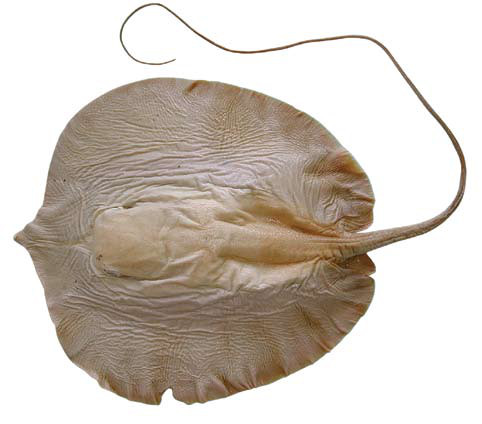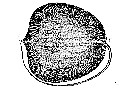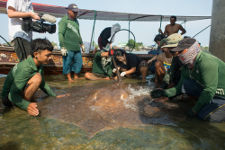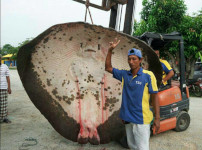Urogymnus polylepis
(Bleeker, 1852)
Scaly whipray
Classification: Elasmobranchii Myliobatiformes Dasyatidae
Reference of the original description
Bijdrage tot de kennis der Plagiostomen van den Indischen Archipel. Verhandelingen van het Bataviaasch Genootschap van Kunsten en Wetenschappen, 24(art. 12): 1–92, Pls. 1–4
Bijdrage tot de kennis der Plagiostomen van den Indischen Archipel. Verhandelingen van het Bataviaasch Genootschap van Kunsten en Wetenschappen, 24(art. 12): 1–92, Pls. 1–4
Synonyms / new combinations and misspellings
Dasyatis chaophraya, Himantura chaophraya, Himantura chaophrya, Himantura polylepis, Trygon polylepis, Trygon (Himantura) polylepis, Urogymnus chaophraya, Urogymnus laevior
Dasyatis chaophraya, Himantura chaophraya, Himantura chaophrya, Himantura polylepis, Trygon polylepis, Trygon (Himantura) polylepis, Urogymnus chaophraya, Urogymnus laevior
Types
Urogymnus polylepis
Himantura chaophraya
Holotype: KUMF: 2998; Paratype: KUMF: 2999; KUMF: 3000;
Trygon polylepis
Holotype: RMNH: 7452
Urogymnus laevior
Holotype: Gov. Mus. Chennai: ?;
Urogymnus polylepis
Himantura chaophraya
Holotype: KUMF: 2998; Paratype: KUMF: 2999; KUMF: 3000;
Trygon polylepis
Holotype: RMNH: 7452
Urogymnus laevior
Holotype: Gov. Mus. Chennai: ?;
Description :
Citation: Urogymnus polylepis (Bleeker, 1852): In: Database of modern sharks, rays and chimaeras, www.shark-references.com, World Wide Web electronic publication, Version 01/2026
Please send your images of "Urogymnus polylepis" to info@shark-references.com

Urogymnus polylepis (Bleeker, 1852) juvenile male holotype (RMNH T 7452, 301 mm DW, preserved). In: Last, P.R. & Manjaji-Matsumoto, B.M. (2008): Himantura dalyensis sp. nov, a new estuarine whipray (Myliobatoidei: Dasyatidae) from northern Australia. CSIRO Marine and Atmospheric Research Paper, 22: 283-292

Urogymnus polylepis (Bleeker, 1852) juvenile male holotype (RMNH T 7452, 301 mm DW, preserved). In: Last, P.R. & Manjaji-Matsumoto, B.M. (2008): Himantura dalyensis sp. nov, a new estuarine whipray (Myliobatoidei: Dasyatidae) from northern Australia. CSIRO Marine and Atmospheric Research Paper, 22: 283-292
Common names
Freshwater whipray
Freshwater whipray
Short Description
Dorsal spines (total): 0; Dorsal soft rays (total): 0. Absence of ventral and dorsal skin folds on the tail, and the broad greyish to blackish marginal band on the ventral surface of the disc. The dorsal surface of the disc is brown (Ref. 27732). Spiral valve with 21 turns; dorsal surface with uniform brown or grey coloration (Ref. 12693). Lacking caudal fin; with long whip-like tail (Ref. 43281).
Dorsal spines (total): 0; Dorsal soft rays (total): 0. Absence of ventral and dorsal skin folds on the tail, and the broad greyish to blackish marginal band on the ventral surface of the disc. The dorsal surface of the disc is brown (Ref. 27732). Spiral valve with 21 turns; dorsal surface with uniform brown or grey coloration (Ref. 12693). Lacking caudal fin; with long whip-like tail (Ref. 43281).
Distribution
Asia and Oceania: Mekong and Chao Phraya basins; also from eastern Borneo, New Guinea and northern Australia.
: First record: 2016: Iqbal & Yustian, 2016: [24689]: 12 confirmed records between 2008 and 2016, from estuaries to about 170 km inland of Sumatra. Source: www.gbif.org
Asia and Oceania: Mekong and Chao Phraya basins; also from eastern Borneo, New Guinea and northern Australia.
: First record: 2016: Iqbal & Yustian, 2016: [24689]: 12 confirmed records between 2008 and 2016, from estuaries to about 170 km inland of Sumatra. Source: www.gbif.org
Human uses
Fisheries: minor commercial; aquaculture: experimental; aquarium: potential
Fisheries: minor commercial; aquaculture: experimental; aquarium: potential
Biology
Exhibit ovoviparity (aplacental viviparity), with embryos feeding initially on yolk, then receiving additional nourishment from the mother by indirect absorption of uterine fluid enriched with mucus, fat or protein through specialised structures (Ref. 50449). Distinct pairing with embrace (Ref. 205). Young are born at about 30 cm disc width (Ref. 6871).
Exhibit ovoviparity (aplacental viviparity), with embryos feeding initially on yolk, then receiving additional nourishment from the mother by indirect absorption of uterine fluid enriched with mucus, fat or protein through specialised structures (Ref. 50449). Distinct pairing with embrace (Ref. 205). Young are born at about 30 cm disc width (Ref. 6871).
Size / Weight / Age
Max length : 240 cm WD male/unsexed; (Ref. 27732); max. published weight: 600.0 kg (Ref. 6871)
Max length : 240 cm WD male/unsexed; (Ref. 27732); max. published weight: 600.0 kg (Ref. 6871)
Habitat
Inhabits sandy bottoms in estuaries and large rivers (Ref. 12693). Feeds on benthic invertebrates (Ref. 12693) and fishes (Ref. 32457). Ovoviviparous (Ref. 50449). Caught occasionally by demersal gillnet and longline fisheries operating in riverine and estuarine areas. Utilized for its meat and possibly its cartilage (Ref.58048). Marketed fresh, with large individuals being sold in cut pieces by the kilogram (Ref. 12693). Size reaches to about 500 cm TL. Threatened due to over harvesting and pollution (Ref. 58490).
Inhabits sandy bottoms in estuaries and large rivers (Ref. 12693). Feeds on benthic invertebrates (Ref. 12693) and fishes (Ref. 32457). Ovoviviparous (Ref. 50449). Caught occasionally by demersal gillnet and longline fisheries operating in riverine and estuarine areas. Utilized for its meat and possibly its cartilage (Ref.58048). Marketed fresh, with large individuals being sold in cut pieces by the kilogram (Ref. 12693). Size reaches to about 500 cm TL. Threatened due to over harvesting and pollution (Ref. 58490).
Remarks
shark-references Species-ID=14663;
shark-references Species-ID=14663;
Parasites (arranged by Jürgen Pollerspöck)
Cestoda
Cestoda
- Acanthobothrium asnihae Fyler & Caira, 2006 [7585] [28741]
- Acanthobothrium etini Fyler & Caira, 2006 [7585] [28741]
- Acanthobothrium masnihae Fyler & Caira, 2006 [7585] [28741]
- Acanthobothrium saliki Fyler & Caira, 2006 [7585] [28741]
- Acanthobothrium zainali Fyler & Caira, 2006 [7585] [28741]
- Prochristianella clarkeae Beveridge, 1990 [17404] [21816]
- Proemotobothrium linstowi (Southwell, 1912) [21816]
- Rhinebothrium abaiense Healy, 2006 [7623]
- Rhinebothrium megacanthophallus Healy, 2006 [7623] [16908]
- Sungaicestus kinabatanganensis (Healy, 2006) [7623] [25321]
- Tetragonocephalum georgei Jensen & Guyer, 2021 [29410]
- Tetragonocephalum levicorpum Jensen & Guyer, 2021 [29410]
- Tetragonocephalum opimum Jensen & Guyer, 2021 [29410]




















